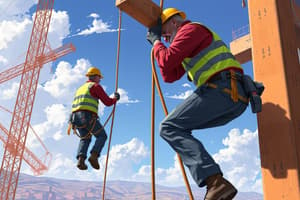Podcast
Questions and Answers
How often must first aid kits on a construction site be checked?
How often must first aid kits on a construction site be checked?
- Biannually
- Monthly
- Daily
- Weekly (correct)
Which of the following defines a competent person in a workplace?
Which of the following defines a competent person in a workplace?
- A supervisor with management experience
- An individual designated by the employer with authority to act (correct)
- Any employee who has been trained in safety procedures
- A person with general work experience
What is the maximum allowed worker exposure to lead in air (in micrograms)?
What is the maximum allowed worker exposure to lead in air (in micrograms)?
- 25 micrograms
- 150 micrograms
- 50 micrograms (correct)
- 100 micrograms
What action must abatement workers take at the end of a shift when a shower is not provided?
What action must abatement workers take at the end of a shift when a shower is not provided?
What is the required distance for a safe means of egress in trench excavations?
What is the required distance for a safe means of egress in trench excavations?
Under which condition is a personal fall arrest system necessary?
Under which condition is a personal fall arrest system necessary?
How far must flammable liquids be stored away from a structure?
How far must flammable liquids be stored away from a structure?
What is the proper angle for setting up a ladder?
What is the proper angle for setting up a ladder?
What is the primary responsibility of employers on a construction job site?
What is the primary responsibility of employers on a construction job site?
What is the maximum distance that materials can be dropped without requiring an enclosed chute?
What is the maximum distance that materials can be dropped without requiring an enclosed chute?
How often should first aid kits on construction sites be inspected?
How often should first aid kits on construction sites be inspected?
What is considered the acceptable cumulative noise exposure threshold in decibels for employees over an 8-hour workday?
What is considered the acceptable cumulative noise exposure threshold in decibels for employees over an 8-hour workday?
When is a fall protection plan not required to include administrative notes?
When is a fall protection plan not required to include administrative notes?
What is the maximum amount of hazardous material that can be stored inside a single-family home closet?
What is the maximum amount of hazardous material that can be stored inside a single-family home closet?
Which safety measure is mandated for roofs more than 6 feet above a lower level?
Which safety measure is mandated for roofs more than 6 feet above a lower level?
What is the correct method to secure an extension cord to a ceiling?
What is the correct method to secure an extension cord to a ceiling?
What is the purpose of having a competent person on a job site?
What is the purpose of having a competent person on a job site?
Which of the following is not a requirement related to hearing protection?
Which of the following is not a requirement related to hearing protection?
Which safety standard must be adhered to when materials are dropped more than 20 feet?
Which safety standard must be adhered to when materials are dropped more than 20 feet?
What is the maximum distance that a ladder's base should be from a wall?
What is the maximum distance that a ladder's base should be from a wall?
Which type of fire extinguisher is required on a job site with 5 gallons of flammable liquid?
Which type of fire extinguisher is required on a job site with 5 gallons of flammable liquid?
What action is required regarding lead exposure assessment prior to demolition?
What action is required regarding lead exposure assessment prior to demolition?
What is the required wash-up procedure for abatement workers at the end of a shift?
What is the required wash-up procedure for abatement workers at the end of a shift?
Flashcards
OSHA Competent Person
OSHA Competent Person
A person who knows relevant safety standards, can identify hazards, and is designated by the employer with the authority to take action.
Maximum Lead Exposure
Maximum Lead Exposure
50 micrograms of lead per cubic meter of air.
Trench Excavation Egress
Trench Excavation Egress
Trench excavations 4 feet or more deep must have a stairway, ladder, ramp, or other safe exit requiring no more than 25 feet of lateral travel for workers.
Fall Protection for Elevated Surfaces
Fall Protection for Elevated Surfaces
Signup and view all the flashcards
Ladder Placement
Ladder Placement
Signup and view all the flashcards
Flammable Liquid Storage
Flammable Liquid Storage
Signup and view all the flashcards
Hearing Protection Threshold
Hearing Protection Threshold
Signup and view all the flashcards
Employee Safety Responsibility
Employee Safety Responsibility
Signup and view all the flashcards
First Aid Kits
First Aid Kits
Signup and view all the flashcards
OSHA Stands For...
OSHA Stands For...
Signup and view all the flashcards
Lead Exposure Limit
Lead Exposure Limit
Signup and view all the flashcards
Abatement Workers
Abatement Workers
Signup and view all the flashcards
Employer Exposure Assessment
Employer Exposure Assessment
Signup and view all the flashcards
Material Drops
Material Drops
Signup and view all the flashcards
Roof Fall Protection
Roof Fall Protection
Signup and view all the flashcards
OSHA's Purpose
OSHA's Purpose
Signup and view all the flashcards
First Aid Kit Check
First Aid Kit Check
Signup and view all the flashcards
Hearing Protection
Hearing Protection
Signup and view all the flashcards
Trench Excavation Safety
Trench Excavation Safety
Signup and view all the flashcards
Fall Protection on Roofs
Fall Protection on Roofs
Signup and view all the flashcards
Study Notes
OSHA Information
- First aid kits: Checked weekly on construction sites.
- Construction worker deaths: 6000 per year, work-related.
- Lunchroom location: Positioned as far away as possible from abatement projects.
- Competent person: Person who understands safety standards and is authorized to take action (designated by employer).
- OSHA: Occupational Safety and Health Administration.
- Safety inspections: Conducted by competent person on job sites.
- Lead exposure limit: Maximum allowed worker exposure is 50 micrograms of lead per cubic meter of air.
- Washing hands: Abatement workers must wash hands and face at the end of a shift, if a shower is not available.
- Lead exposure assessments: Employer exposure assessments evaluate lead exposure risk before demolition.
- Stairways, ladders etc. in trenches: Safe access must be within 25 feet of lateral travel for employees.
- Dropping materials: Material drops over 20 feet must use enclosed chutes.
- Roof protection: Roofs over 6 feet from lower level require fall protection measures.
- Fall protection plan: Administrative notes are not required.
- Flammable liquid storage: 25 gallons maximum flammable liquid storage inside single-family homes, must be 15 feet from a structure.
- Ladder safety: Ladders must extend 3 feet beyond roof eaves.
- Proper ladder angle: Ladder base should be 1/4 of its working length from a wall.
- Noise limits: Exposure to 90 decibels or more requires hearing protection for 8-hour workdays.
- Extension cord securement: Extension cords should be secured to ceilings using cords or strings.
- Employer responsibility: Employers are responsible for employee safety on the jobsite.
Studying That Suits You
Use AI to generate personalized quizzes and flashcards to suit your learning preferences.




